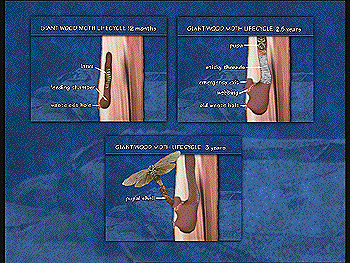Giant Wood Moths
Qantas Amazing Australia
Recently on ‘Burke’s Backyard’ Don and Dr Geoff Monteith, Senior Curator of Insects at the Queensland Museum, went on the hunt for the Giant Wood Moth, which is a fascinating part of garden ecology. The larvae are better known as witchetty grubs. Although these huge grubs, which burrow into the trunks of trees look destructive and may be found in dying trees, they often won’t be the cause of a tree’s death as they do not burrow deep into the tree.
Plants affected
Eucalyptus trees are the only trees affected by Giant Wood Moths (Endoxyla cinereus formerly known as Xyleutes cinereus), however other species of wood moth do affect other trees including wattles. Unhealthy trees will be more prone to attack. Older trees usually suffer no permanent damage but the tunnelling of the grubs in younger trees may weaken the trunk, which could cause it to snap in a strong wind.
Affected areas Northern Queensland to southern New South Wales but not a common sight in the Sydney region.
Common along the Queensland coast and Brisbane area.
How to tell if you have Giant Wood Moths in your garden
One of the most obvious signs is the sawdust-like material which you’ll find at the base of the affected tree or around the hole itself. If the larvae hole is very new a cap of this sawdust or frass (droppings) mixed with silk will cover the newly made hole, protecting the grub from predators and parasites as it burrows into the trunk.
Another sign of wood moth activity, which will often catch your eye, is the empty chrysalis poking out from the hole after the moth has hatched, around Christmas-time.
What should you do?
1. Do nothing. According to Geoff Monteith you should appreciate seeing this wonder in your garden. The moth may not be the cause of an ill looking tree – it may be the result of damage from other sources.
A flock of Yellow-tailed Black Cockatoos which enjoy eating the moths can cause worse damage to trees as they try to pull away the bark to reveal the juicy larval morsels. According to Geoff, these birds can almost sever a tree’s stem.
2. Look after trees. Keeping your trees in good condition lessens the chances of an infestation of Giant Wood Moths (and other wood boring insects), so check to see they’re receiving enough water or that the drainage is adequate. Do not disturb the ground around a tree or park cars or heavy equipment under them as this causes stress that can lead to a weakening of a tree.
If a tree is under stress, an application of Seasol around the base of the tree will help keep your trees in tip top condition (see fact sheet, ‘Fertilising a Big Tree’, for more details).
Did you know?
The Giant Wood Moth is the heaviest moth in the world, with some females weighing up to 30 grams. Moths with this weight measure 5cm (2″) in length. This large weight and size is because her abdomen can hold up to 20,000 minute yellow eggs.
Further information
A leaflet on Giant Wood Moths is available from the Queensland Museum. The Queensland Museum is at the corner of Melbourne and Gray Streets, South Brisbane, Qld, 4101. Phone: (07) 3840 7635. The museum is open daily from 9.00am to 5.00pm (closed Christmas Day and Good Friday). Admission is free.
For those who would like to become involved with the museum, membership of the Queensland Museum Association Inc is available. For more information write to: PO Box 3300, South Brisbane, Qld, 4101. Membership: Single – $25; Family – $30; Concession – $20. Phone: (07) 3840 7632.
Insect details
Scientific name: Endoxyla cinereus (formerly known as Xyleutes cinereus)
Common name: Giant Wood Moth
Description: Larvae are large, fleshy and creamy white in colour. They are a type of witchetty grub. They may grow up to 15cm (6″) in length. Their cream coloured body is banded with purple as a warning colour for protection from predators. The grubs are vulnerable to predation during their crawl up the tree trunk to the place where they bore a hole.
The adult moth is a dull grey colour with a dark blotch on the thorax. Their wingspan can reach up to 25cm (10″) with the female moth twice the size of the male. The moths are camouflaged when resting during the day as their wings fold alongside their bodies.
Lifecycle of the Giant Wood Moth: The larvae of the wood moth burrow into trees and remain there for up to one year before emerging as moths. They usually live for only a few days after hatching and during this time they mate.
Giant Wood Moths can lay up to 20,000 eggs before dying. These are laid in bark crevices and protected by a sticky secretion. Once hatched, the 1.5mm caterpillars lower themselves to the ground on threads made of a silky material. It is still a mystery as to where the larvae spend their first 12 months of life, but it is thought that they may feed on roots for this first year as do some other species of Endoxyla (Xyleutes), such as the Desert Witchetty Grub (X. leucomochla).
At around 12 months old the grubs are the thickness of a lead pencil and approximately 25mm (1″) long and it is only after this time that they burrow into tree trunks.
The larvae bore large diameter holes for protection but do not bore far into the tree. Affected trees try to repair the hole and it is on this regenerating callus tissue that the grubs feed. The hole will eventually heal after about two years with only the characteristic ‘double scars’ to tell of its previous occupant.



